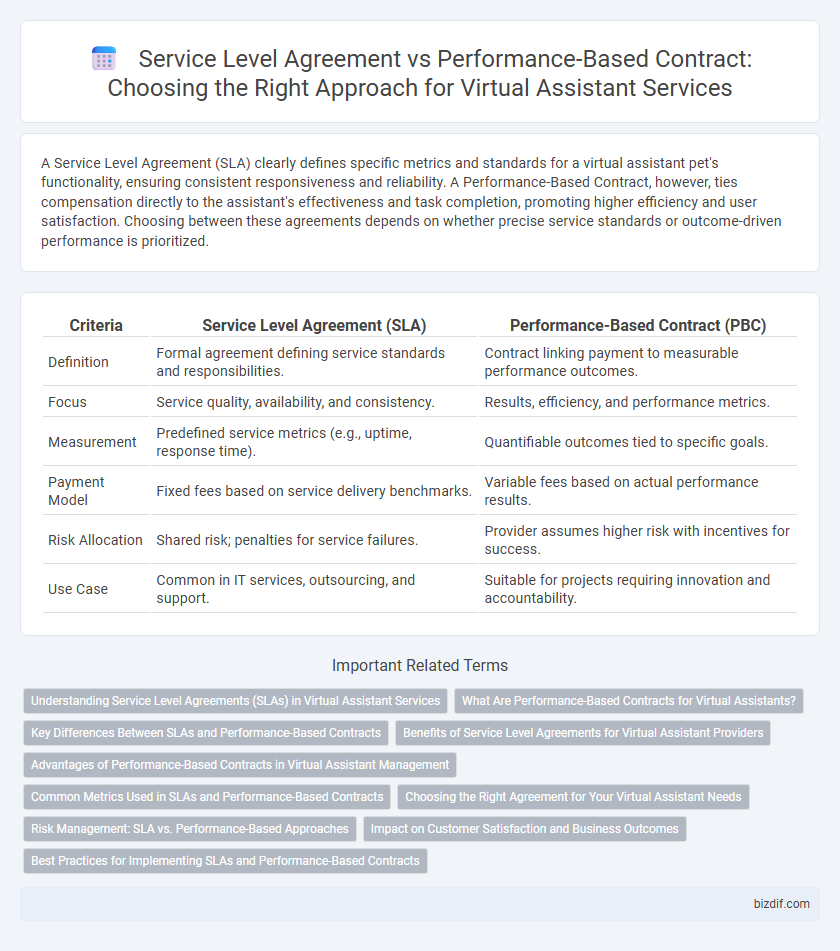A Service Level Agreement (SLA) clearly defines specific metrics and standards for a virtual assistant pet's functionality, ensuring consistent responsiveness and reliability. A Performance-Based Contract, however, ties compensation directly to the assistant's effectiveness and task completion, promoting higher efficiency and user satisfaction. Choosing between these agreements depends on whether precise service standards or outcome-driven performance is prioritized.
Table of Comparison
| Criteria | Service Level Agreement (SLA) | Performance-Based Contract (PBC) |
|---|---|---|
| Definition | Formal agreement defining service standards and responsibilities. | Contract linking payment to measurable performance outcomes. |
| Focus | Service quality, availability, and consistency. | Results, efficiency, and performance metrics. |
| Measurement | Predefined service metrics (e.g., uptime, response time). | Quantifiable outcomes tied to specific goals. |
| Payment Model | Fixed fees based on service delivery benchmarks. | Variable fees based on actual performance results. |
| Risk Allocation | Shared risk; penalties for service failures. | Provider assumes higher risk with incentives for success. |
| Use Case | Common in IT services, outsourcing, and support. | Suitable for projects requiring innovation and accountability. |
Understanding Service Level Agreements (SLAs) in Virtual Assistant Services
Service Level Agreements (SLAs) in virtual assistant services define clear expectations, specifying response time, task accuracy, and availability metrics to ensure consistent support quality. Unlike performance-based contracts, SLAs focus on measurable service standards rather than outcome incentives, providing a structured framework for accountability. Effective SLAs enhance client satisfaction by establishing transparent benchmarks that virtual assistant providers must consistently meet.
What Are Performance-Based Contracts for Virtual Assistants?
Performance-based contracts for virtual assistants emphasize measurable outcomes and specific deliverables rather than predefined tasks or hours worked. These contracts tie compensation to achieving key performance indicators (KPIs) such as response time, task completion rate, or customer satisfaction scores, ensuring alignment with business goals. Unlike traditional service level agreements (SLAs), performance-based contracts prioritize efficiency and results, fostering accountability and continuous improvement in virtual assistant services.
Key Differences Between SLAs and Performance-Based Contracts
Service Level Agreements (SLAs) define specific metrics and standards for virtual assistant services, ensuring consistent response time, accuracy, and availability. Performance-based contracts tie compensation directly to the achievement of predefined outcomes, such as task completion rates or customer satisfaction scores. While SLAs emphasize service quality benchmarks, performance-based contracts focus on measurable results and accountability.
Benefits of Service Level Agreements for Virtual Assistant Providers
Service Level Agreements (SLAs) for virtual assistant providers ensure clear expectations on response times, task accuracy, and availability, enhancing client satisfaction and trust. SLAs enable consistent service quality through measurable performance metrics, reducing disputes and improving accountability. Defined SLAs facilitate efficient resource allocation and operational planning, increasing overall productivity and client retention.
Advantages of Performance-Based Contracts in Virtual Assistant Management
Performance-based contracts in virtual assistant management emphasize measurable outcomes, ensuring accountability and enhanced productivity through clear performance metrics. These contracts align incentives with specific goals, resulting in improved quality of service and cost efficiency compared to traditional service level agreements. By focusing on deliverables, businesses can optimize virtual assistant performance and foster continuous improvement.
Common Metrics Used in SLAs and Performance-Based Contracts
Service level agreements (SLAs) typically focus on metrics such as response time, uptime percentage, and resolution time to ensure consistent virtual assistant performance. Performance-based contracts emphasize outcome-oriented metrics like user satisfaction scores, task completion rates, and cost efficiency to align incentives with business objectives. Both frameworks use key performance indicators (KPIs) to measure effectiveness but prioritize different aspects of service delivery.
Choosing the Right Agreement for Your Virtual Assistant Needs
Selecting the appropriate agreement for virtual assistant services hinges on understanding the distinctions between a Service Level Agreement (SLA) and a Performance-Based Contract (PBC). SLAs emphasize predefined service standards and response times, ensuring consistent support quality, while PBCs tie compensation directly to the assistant's performance outcomes and task completion metrics. An informed decision requires evaluating your virtual assistant needs, whether prioritizing reliability and service consistency or incentivizing productivity and goal achievement.
Risk Management: SLA vs. Performance-Based Approaches
Service Level Agreements (SLAs) define specific, measurable service metrics to ensure consistent virtual assistant performance, mitigating risks related to service availability and response times. Performance-based contracts shift risk by linking compensation to outcomes, incentivizing higher productivity but requiring precise performance tracking and clear deliverables. Both approaches address risk management, with SLAs emphasizing compliance with agreed standards and performance-based contracts focusing on result-driven accountability.
Impact on Customer Satisfaction and Business Outcomes
Service level agreements (SLAs) define clear metrics for virtual assistant responsiveness and issue resolution, directly influencing customer satisfaction by ensuring consistent service quality. Performance-based contracts link compensation to measurable outcomes like customer engagement rates and resolution times, driving virtual assistants to optimize business outcomes and enhance user experience. Establishing these agreements helps businesses align virtual assistant performance with strategic goals, fostering improved satisfaction and tangible results.
Best Practices for Implementing SLAs and Performance-Based Contracts
Establish clear, measurable metrics aligned with virtual assistant tasks to ensure effective Service Level Agreements (SLAs) and performance-based contracts. Define mutual expectations, response times, accuracy rates, and resolution benchmarks to enhance accountability and service quality. Continuous monitoring and regular reviews foster adaptability, driving consistent improvements in virtual assistant performance.
Service level agreement vs Performance-based contract Infographic

 bizdif.com
bizdif.com